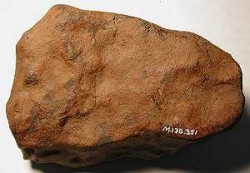If you’ve ever held a real meteorite in your hand, you probably wanted to know, “Where has this rock been in space and where did it come from?” Until now, no one has been able to definitively establish where the majority of meteorites found on Earth came from because of the changes that occur in meteorites after they are ejected from the asteroids they were originally part of. The most common type of meteorite found on Earth, about 75% of those identified, are chondrites, stony bits of space rocks that didn’t undergo any melting while out in space. Two astronomers say have determined that most of these meteorites come from the asteroid belt between Mars and Jupiter. Using the GEMINI telescope, they found that asteroids in that region are similar to chondrites found on Earth.
This discovery is the first observational match between the most common meteorites and asteroids in the main belt. It also confirms the role of space weathering in altering asteroid surfaces.
To find the parent asteroid of a meteorite, the astronomers compared the spectra of a meteorite specimen to those of asteroids. This is a difficult task because meteorites and their parent asteroids underwent different processes after the meteorite was ejected. In particular, surfaces of asteroids are known to be altered by a process called “space weatheringâ€, which is probably caused by micrometeorite and solar wind action that changes the surface and spectra of asteroid surfaces.

Meteoroids are created, usually when there is a collision between asteroids. When an impact of a large asteroid occurs, the fragments broken off can follow the same orbit as the primary asteroid. These groups of fragments are called “asteroid families.†Until recently, most of the known asteroid families have been very old (they were formed 100 million to billions of years ago), and younger families are more difficult to detect because asteroid fragments are closer to each other.
In 2006, four new, extremely young asteroid families were identified, with an age ranging from 50,000 to 600,000 years. The astronomers, Thais Mothé-Diniz from Brazil and David Nesvorný from the US observed these asteroids, obtaining visible spectra. They compared the asteroids spectra to the spectra of an ordinary chondrite (the Fayetteville meteorite, shown in the top photo) and found they matched.
Identifying the parent asteroid of a meteorite is a unique tool when studying the history of our solar system because one can infer both the time of geological events (from the meteorite that can be analyzed through dating techniques) and their location in the solar system (from the location of the parent asteroid).
Meteorites are also a major tool for knowing the history of the solar system because their composition is a record of past geologic processes that occurred while they were still incorporated in the parent asteroid.
Original News Source: Astronomy and Astrophysics


Wow. I guess, the visible spectra of the Gemini scope would have been deduced from reflected sunlight, but how did they obtain spectra from their eairth-based samples? Was it a destructive analytical technique?
I believe the Nickel/Iron impacter that formed the Winslow Crater is right at 4.6 billion years old. I was under the impression that most, if not all, Ni/Fe meteors are thought to be that old. Is this true?